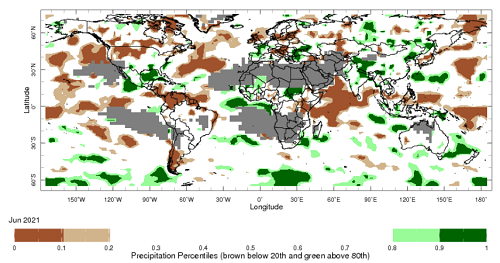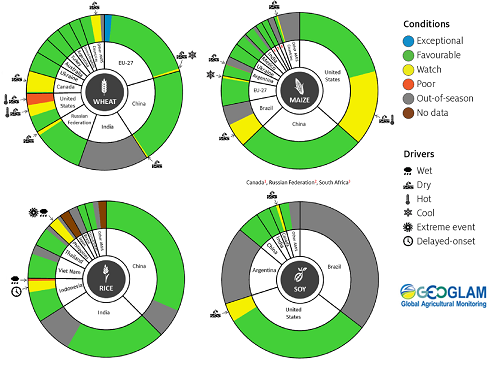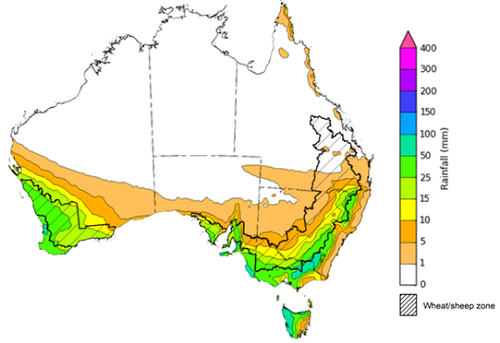Key issues
- During the week ending 14 July 2021, low pressure troughs and cold fronts brought moderate rainfall to parts of western and eastern Australia.
- The rainfall across some south-eastern Australian cropping regions has provided much needed moisture to parts of north-western Victoria to assist with winter crop germination and establishment. However, cropping regions with below average soil moisture in eastern South Australia recorded little rainfall to assist with winter crop germination and establishment.
- As at 28 June 2021 global production conditions were generally favourable. A lack of precipitation and excessive heat has affected the production potential of wheat, corn and soy in some key grain exporters and importers.
- Production conditions for wheat and corn have declined during June in some key grain exporters when compared to those conditions that were expected back in April, which were used to formulate ABARES forecasts of global grain supplies and world prices in its June 2021 edition of Agricultural commodities.
- The global climate outlook indicates that average to above average rainfall is more likely between August and October 2021 for most of the world's major grain-producing and oilseed-producing regions. If realised, this is likely to benefit corn, soybeans, sunflower, millet, rice, sorghum, groundnuts and cotton production in the northern hemisphere, and winter wheat and canola production in Australia.
- However, below average rainfall is more likely across parts of Argentina and southern Brazil. This would adversely affect the development of wheat crops. Below average rainfall between August and October 2021 is also more likely for parts of northern Europe and much of western United States of America. In these northern hemisphere growing regions, this is likely to adversely affect the development of spring wheat, canola, corn, cotton, soybeans, sorghum and sunflower.
- In the next eight days, rainfall totals of between 10 and 50 millimetres are forecast for cropping regions across much of eastern New South Wales and much of Victoria and Western Australia, as well as central and western areas of South Australia. If realised, the falls forecast across New South Wales, Victoria, South Australia, and Western Australia will likely support the growth of early sown winter crops. However, further rainfall is likely to exacerbate the effects of waterlogging in some southern Victorian and Western Australian growing regions.
- Water storage in the Murray–Darling Basin (MDB) increased by 265 gigalitres (GL) between 7 July 2021 and 14 July 2021. The current volume of water held in storage is 16,695 GL, which represents 67% of total capacity. This is 47% or 5,382 GL more than at the same time last year.
- Allocation prices in the Victorian Murray below the Barmah Choke increased from $90 per ML on 30 June 2021 to $184 per ML on 9 July 2021. Prices are lower in the Goulburn-Broken, Murrumbidgee, and regions above the Barmah choke due to the binding of the Goulburn intervalley trade limit, Murrumbidgee export limit, and Barmah choke trade constraint.
Climate
[expand all]
Rainfall this week
During the week ending 14 July 2021, low pressure troughs and cold fronts brought moderate rainfall to parts of western and eastern Australia. High pressure systems restricted rainfall across much of the remainder of Australia.
Rainfall totals of between 10 and 50 millimetres were recorded across parts of north-eastern New South Wales, south-eastern and central Queensland, the west of Western Australia, and scattered areas of South Australia, Victoria, and northern Tasmania. Rainfall totals in excess of 50 millimetres were recorded across the far southwest of Western Australia.
In cropping regions, rainfall totals of between 10 and 50 millimetres were recorded across much of northern New South Wales, southern Queensland, parts of western Victoria, and western and central Western Australia. Rainfall totals of between 1 and 10 millimetres were recorded across remaining cropping regions in New South Wales, Victoria, South Australia, central Queensland and south-eastern Western Australia during the week ending 14 July 2021.
The rainfall across some south-eastern Australian cropping regions has provided much needed moisture to parts of north-western Victoria to assist with winter crop germination and establishment. This rainfall will also support the development of established crops in northern New South Wales and southern Queensland. Cropping regions with below average soil moisture in eastern South Australia recorded little rainfall to assist with winter crop germination and establishment.
Rainfall for the week ending 14 July 2021
©Commonwealth of Australia 2021, Australian Bureau of Meteorology - Issued: 14/07/2021
Note: The rainfall analyses and associated maps utilise data contained in the Bureau of Meteorology climate database, the Australian Data Archive for Meteorology (ADAM). The analyses are initially produced automatically from real-time data with limited quality control. They are intended to provide a general overview of rainfall across Australia as quickly as possible after the observations are received. For further information go to http://www.bom.gov.au/climate/rainfall/
Global production conditions and climate outlook
Crop production is affected by long-term trends in average rainfall and temperature, interannual climate variability, shocks during specific growth stages, and extreme weather events (IPCC 2012). Some crops are more tolerant than others to certain types of stresses, and at each growth stage, different types of stresses affect each crop species in different ways.
The precipitation anomalies and outlooks presented here give an indication of the current and future state of production conditions for the major grain and oilseed producing countries which are responsible for over 80% of global production. This is an important input to assessing the global grain supply outlook.
As of the end of June 2021, rainfall was generally favourable for the world’s major grain and oil producing regions.
In the northern hemisphere, June precipitation was above average in parts of central Africa, south-western and north-eastern China, western Europe, India, the south-west of the Russian Federation, Ukraine, Turkey, and parts of southern United States of America.
Precipitation was below average across much of southern Canada, the north of the United States of America, central and northern Europe, Kazakhstan, and the west of the Russian Federation. Precipitation was generally average across the remainder of major grain and oil producing regions in the northern hemisphere.
In the southern hemisphere, June precipitation was below average across much of southern Argentina and parts of western Australia. Precipitation was generally average to above average across the remainder of major grain and oil producing regions in the southern hemisphere.
Global precipitation percentiles, June 2021
Note: The world precipitation percentiles indicate a ranking of precipitation for June, with the driest (0th percentile) being 0 on the scale and the wettest (100th percentile) being 1 on the scale. Percentiles are based on precipitation estimates from the NOAA Climate Prediction Center's Climate Anomaly Monitoring System Outgoing Precipitation Index dataset. Precipitation estimates for June 2021 are compared with rainfall recorded for that period during the 1981 to 2010 base period.
Source: International Research Institute for Climate and Society
As at 28 June 2021 global production conditions were generally favourable. However, a lack of precipitation and excessive heat has affected the production potential of wheat, corn and soy in some key grain exporters and importers.
Conditions for wheat development were generally favourable in Australia, Argentina, China, the European Union, the Russian Federation, Turkey, United Kingdom, and Ukraine. Dry and unseasonably hot temperatures have resulted in variable production prospects across parts of much of Canada, Kazakhstan, for much of northern and parts of central United States of America (US).
Conditions for corn in Argentina were generally favourable as harvest commences for the late-planted crop. In Brazil, production potential is mixed as harvesting commences due to excessive dryness and frosts during the critical reproductive stage. In Mexico production conditions are favourable for the harvesting of the autumn-winter crop and for the sowing of the spring-summer crop. Conditions were favourable for crop development in China, the European Union, India, Ukraine, and the Russian Federation. In the US, production potential is mixed as persistent hot and dry conditions extend across much of the northern Corn Belt.
Conditions for rice were favourable for crop development in China and the US. Favourable growing conditions have supported average to above average production as harvesting occurs for wet-season rice in Indonesia and dry-season rice in Vietnam. Sowing of rice occurred under favourable conditions in India and Thailand, and for dry-season rice in Indonesia and wet-season rice in Vietnam. In the Philippines, production conditions are mixed for wet-season rice.
Production conditions for soybeans are mixed in Canada and in northern and western areas of the Mid-West of the US as hot and dry conditions persist. Production conditions are favourable across remaining soybean producing regions.
Crop conditions, AMIS countries, 28 June 2021
AMIS Agricultural Market Information System.
Source: AMIS
The global climate outlook for August to October 2021 indicates that average to above average rainfall is more likely for most of the world's major grain-producing and oilseed-producing regions. Outlooks and potential production impacts for the major grain and oilseed producing countries are presented in the table.
| Region | August-October rainfall outlook | Potential impact on production |
|---|---|---|
| Argentina | Below average to average rainfall is expected across most of Argentina between August and October 2021. | Below average rainfall is likely to adversely affect the heading and filling of wheat and planting of corn, cotton and soybeans through September and October. |
| Black Sea Region | Kazakhstan, the Russian Federation and Ukraine - No strong tendency towards either above or below average rainfall between August and October 2021. | Average rainfall between August and October 2021 is likely to support spring wheat filling and harvesting in the north. In the south, average rainfall is likely to support cotton, corn and sunflower development and winter wheat and rapeseed harvesting and planting. |
| Brazil | Above average rainfall is more likely in northern Brazil while below average rainfall is more likely across the south of Brazil. | Below average rainfall in southern Brazil is likely to adversely affect wheat heading and filling in August and September leading up to harvest in October, as well as corn and soybean planting and development in September and October. |
| Canada | There is no strong tendency towards below or above average rainfall across much of Canada between August and October 2021. | Average rainfall is likely to benefit corn, soybeans and sunflower flowering in August and support grain development through September and October. |
| China | Above average rainfall likely across much of eastern China and below average across western China between August and October 2021. | Average to above average rainfall is likely to support the development and harvest of cotton, rice, corn, sorghum, soybean, sunflower, groundnuts and spring wheat. Additionally, average to above average rainfall is likely to support late rice heading in September and planting of winter wheat and rapeseed in October. |
| Europe | Below average rainfall more likely for parts of northern Europe between August and October 2021. | Below average rainfall may adversely impact the yield prospects of corn, cotton and sorghum in northern Europe. Below average rainfall may also impact winter wheat and rapeseed planting in parts of northern Europe during October. |
| South Asia (India) | Above average rainfall between August and October 2021 is likely across much of India. | Above average rainfall is likely to benefit corn, sorghum, rice, millet, groundnuts and sunflower flowering and filling in August and September leading up to harvest in October, and cotton blooming in the south in September. |
| Southeast Asia (SEA) | Above average rainfall is likely for northern SEA, with a strong likelihood of above average rainfall for Indonesia between August and October2021. | Above average rainfall between August and October 2021 is likely to support corn and rice filling and maturing in SEA leading up to harvest in October. |
| The United States of America | Above average rainfall is more likely for much of eastern US and below average is rainfall more likely across much of the western half of the US. | Across the east of the US average to above average rainfall is likely to benefit soybeans, sunflower and millet flowering in August and the development of these crops as well as rice, corn, sorghum and groundnuts leading up to harvest in October. Below average rainfall is likely to continue to adversely affect the yield prospects of corn, spring wheat and soybeans in western US. |
Rainfall forecast for the next eight days
Low pressure systems and troughs are likely to bring showers and storms to parts of south-eastern and south-western Australia during the 8 days to 22 July 2021. High-pressure systems are expected to keep rainfall totals low for the majority of central and northern Australia during the next 8 days.
Rainfall totals of between 10 and 50 millimetres are forecast for parts of eastern New South Wales, much of Victoria, parts of southern South Australia, the southwest of Western Australia and western Tasmania. Rainfall in excess of 50 millimetres is forecast for the alpine areas of New South Wales and Victoria and parts of western Tasmania.
In Australia’s cropping regions, rainfall totals of between 10 and 50 millimetres are forecast eastern New South Wales and much of Victoria and Western Australia, as well as central and western areas of South Australia. Rainfall totals of between 1 and 10 millimetres is expected across remaining cropping regions in New South Wales, northern Victoria and eastern South Australia and parts of southern Queensland.
If realised, the falls forecast across New South Wales, Victoria, South Australia, and Western Australia will likely support the growth of early sown winter crops.
The dry forecast for the next 8 days across cropping regions in Queensland, western New South Wales will allow for the application of fertilizer and post-emergent weed control following this week’s rain. However further rainfall is likely to exacerbate the effects of waterlogging in some southern Victorian and Western Australian growing regions.
Total forecast rainfall (mm) for the period 15 July to 22 July 2021
©Commonwealth of Australia 2021, Australian Bureau of Meteorology - Issued: 15/07/2021
Water
Water storages, water markets and water allocations - current week
The Tableau dashboard may not meet accessibility requirements. For information about the contents of these dashboards contact ABARES.
Commodities
Information on weekly price changes in agricultural commodities is now available at the Weekly commodity price update.




